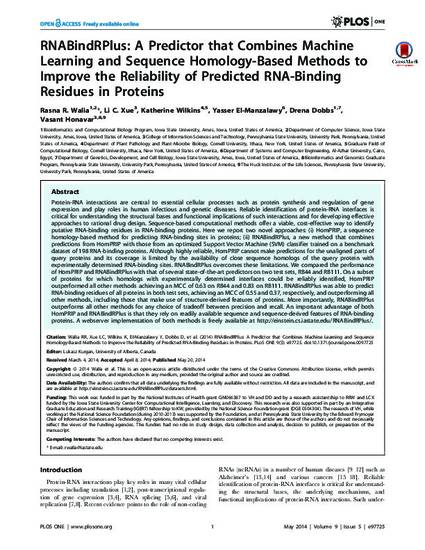
Article
RNABindRPlus: A Predictor that Combines Machine Learning and Sequence Homology-Based Methods to Improve the Reliability of Predicted RNA-Binding Residues in Proteins
PLoS ONE
Document Type
Article
Publication Version
Published Version
Publication Date
5-20-2014
DOI
10.1371/journal.pone.0097725
Abstract
Protein-RNA interactions are central to essential cellular processes such as protein synthesis and regulation of gene expression and play roles in human infectious and genetic diseases. Reliable identification of protein-RNA interfaces is critical for understanding the structural bases and functional implications of such interactions and for developing effective approaches to rational drug design. Sequence-based computational methods offer a viable, cost-effective way to identify putative RNA-binding residues in RNA-binding proteins. Here we report two novel approaches: (i) HomPRIP, a sequence homology-based method for predicting RNA-binding sites in proteins; (ii) RNABindRPlus, a new method that combines predictions from HomPRIP with those from an optimized Support Vector Machine (SVM) classifier trained on a benchmark dataset of 198 RNA-binding proteins. Although highly reliable, HomPRIP cannot make predictions for the unaligned parts of query proteins and its coverage is limited by the availability of close sequence homologs of the query protein with experimentally determined RNA-binding sites. RNABindRPlus overcomes these limitations. We compared the performance of HomPRIP and RNABindRPlus with that of several state-of-the-art predictors on two test sets, RB44 and RB111. On a subset of proteins for which homologs with experimentally determined interfaces could be reliably identified, HomPRIP outperformed all other methods achieving an MCC of 0.63 on RB44 and 0.83 on RB111. RNABindRPlus was able to predict RNA-binding residues of all proteins in both test sets, achieving an MCC of 0.55 and 0.37, respectively, and outperforming all other methods, including those that make use of structure-derived features of proteins. More importantly, RNABindRPlus outperforms all other methods for any choice of tradeoff between precision and recall. An important advantage of both HomPRIP and RNABindRPlus is that they rely on readily available sequence and sequence-derived features of RNA-binding proteins. A webserver implementation of both methods is freely available at http://einstein.cs.iastate.edu/RNABindRPlus/.
Rights
© 2014 Walia et al. This is an open-access article distributed under the terms of the Creative Commons Attribution License, which permits unrestricted use, distribution, and reproduction in any medium, provided the original author and source are credited.
Copyright Owner
Walia et al.
Copyright Date
2014
Language
en
File Format
application/pdf
Citation Information
Rasna R. Walia, Li C. Xue, Katherine E. Wilkins, Yasser El-Manzalawy, et al.. "RNABindRPlus: A Predictor that Combines Machine Learning and Sequence Homology-Based Methods to Improve the Reliability of Predicted RNA-Binding Residues in Proteins" PLoS ONE Vol. 9 Iss. 5 (2014) p. e97725 Available at: http://works.bepress.com/drena-dobbs/5/

This article is from PLoS ONE 9(5): e97725. doi:10.1371/journal.pone.0097725. Posted with permission.